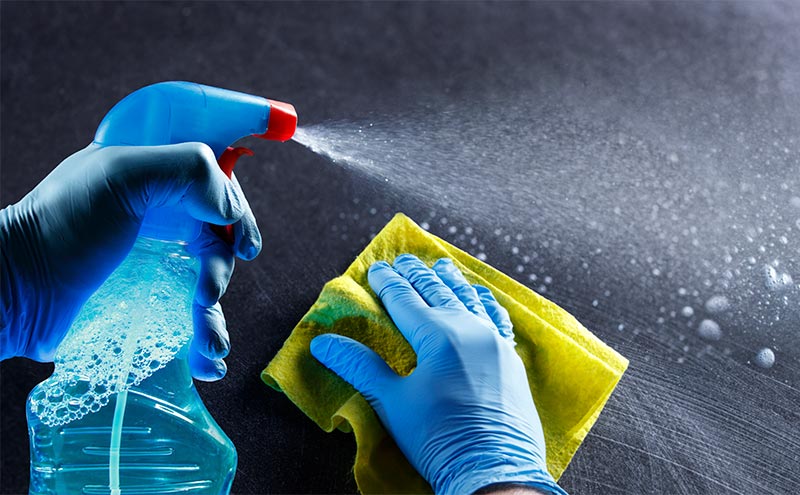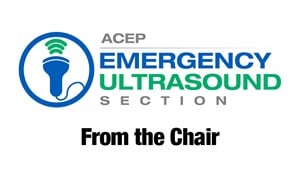
Update on Ultrasound Disinfection
Jason T. Nomura, MD, FACEP, Co-Chair Emergency Ultrasound Section Safety Sub-Committee, Director of Emergency Ultrasound, Medical Director of Systemwide POCUS, Christiana Care Health System, Delaware
Christopher Kumetz, MD, Co-Chair Emergency Ultrasound Section Safety Sub-Committee, Facility Medical Director, NCH Emergency Departments, NCH Point-of-Care Ultrasound Committee Chair, TeamHealth, Naples, Florida
There have been several changes and updates in ultrasound disinfection recently. This was due to the pressures being exerted on ultrasound users to use unnecessary high-level disinfection after every ultrasound guided percutaneous procedure. This was likely secondary to how the CDC’s Guideline for Disinfection and Sterilization in Healthcare Facilities was being misinterpreted along with external industry pressures. In response, an intersocietal position statement was drafted by five of the most influential ultrasound organizations, and our ACEP Guideline for Ultrasound Transducer Cleaning and Disinfection was updated. Rather than repeating the guideline below, we present some important definitions and resources and will provide answers to common questions regarding ultrasound disinfection.
Defining Transducers and Levels of Disinfection
Transducers can be divided into:
- Critical: intra-operative probes placed into sterile body cavities/locations., eg, intra-operative and intra-vascular probes, which are not commonly used in the ED.
- Semicritical: Probes that make contact with mucous membranes, eg, TEE and intra-cavitary probes.
- Noncritical: Probes that make contact with intact skin, eg, phased, curved, and linear array.
Disinfection levels are divided into:
- Low Level: removes most bacteria, excluding tuberculosis
- Intermediate Level: removes bacteria, including vegetative tuberculosis
- High Level: removes bacterial spores
Updated Documents to Have on File
- ACEP Guideline for Ultrasound Transducer Cleaning and Disinfection
- Disinfection of Ultrasound Transducers used for Percutaneous Procedures: Intersocietal Position Statement
- Reprocessing Surface Ultrasound Transducers: Joint Commission on Infection Prevention & Control
Frequently Asked Questions About US Disinfection
1. How do I disinfect my probe after percutaneous procedures?
Use a probe cover during the procedure, then clean the probe with a low-level disinfectant. If the cover fails or is damaged, then use a disinfectant that covers blood-borne pathogens and tubercle bacilli (TB).
2. Why is TB a factor in disinfection agents?
The use of TB is not because of risk of TB with body fluid exposure, but as a marker of disinfectant potency and efficacy.
3. Why does the intersocietal statement and ACEP’s guideline reference disinfectants that are active against blood-borne pathogens and tubercle bacilli?
This in effect means using an intermediate disinfectant. However, low level disinfectants are regulated by the EPA and high-level disinfectants by the FDA. Intermediate disinfectant regulations are shared. Given this, the recommendations from senior authors at the CDC were to use the pathogen coverage rather than intermediate disinfectant, since this could lead to misinterpretations with the operational difficulties around that term.
4. Can I just always use an intermediate disinfectant for the probes rather than changing products based on contamination vs non-contamination?
Yes, this would be the easier option when operationalizing disinfection in your department.
5. Will my infection prevention department support the intersocietal statement and ACEP guideline?
They should, but that can depend on local practice and politics. The intersocietal statement is the basis for the update to the ACEP guideline, which was endorsed by ACEP and AIUM. It was also endorsed by the Association for Professionals in Infection Control and Prevention (APIC) and the Society for Healthcare Epidemiology of America (SHEA), the two groups for infection prevention professionals and physician leaders.
6. Do I still need to use high level disinfection for my TEE and intra-cavitary probe?
Yes, these are semicritical devices and continue to require high level disinfection.
7. What is an IFU?
Instructions For Use, and this is the product instructions and labeling. It is an important document that the Joint Commission references during their accreditation reviews.
8. Why do the statements and guidelines for disinfection mention covers for percutaneous procedures?
The use of the cover or barrier is to reduce contamination of the probe by body fluids and to prevent cross contamination of the patient by the probe as part of the infection prevention.
9. Can I use a transparent IV dressings (eg, Tegaderm) as a probe cover?
Not according to The Joint Commission (TJC). They refer to the Instructions for Use from the manufacturer. These products are site dressings and not labeled for use as a probe cover. TJC recommends using sheaths that are FDA approved as a viral barrier and do not support using other items that are not labeled or intended for that use.
10. Why does my infection prevention department say that I still have to use high level disinfection on my specific ultrasound (eg, Sonosite or other vendors) probes after percutaneous procedures?
Some manufacturer’s IFUs recommend using high level disinfection if there is body fluid contamination. However, Fujifilm/Sonosite have updated their IFU to match the intersocietal statement for disinfection.
https://www.sonosite.com/support/userdocs/Sonosite_UltrasoundSystem_UG_Errata_14Lgs_P23353-01C_e.pdf
The hierarchy usually is National Guidelines (FDA, CDC, EPA, etc), then manufacturer IFUs, Medical Society statements, and local hospital guidelines. You will have to check the IFU for your specific ultrasound system and probe.
11. How do I pick an appropriate disinfectant to use on my ultrasound systems?
a. First check your ultrasound system’s IFU for which disinfectants are approved for use on the system and probes.
b. Then look for a disinfectant that is activate against Hep B, Hep C, and HIV for low level disinfection with the addition of TB for intermediate level disinfection.
c. You can find the activity coverage of the agent on their product labeling. If it is not available, use the disinfectant’s EPA registration number to check the activity level. Use the EPA registration number since product names can change over time or the manufacturer may change. Some products may also have very similar names but different coverage.
i. List B: agents active against TB
ii. List D: agents active against HIV and Hep B
iii. List F: agents active against Hep C
iv. The EPA list of lists https://www.epa.gov/pesticide-registration/selected-epa-registered-disinfectants
d. Here is a brief list of some common agents used for ultrasound disinfection that are active against Hep B, Hep C, HIV, and TB.
|
Manufacturer |
Product Name |
Active Ingredient |
EPA Reg Number |
|
Clorox |
Clorox HeathCare Hydrogen Peroxide |
1.4% Hydrogen Peroxide |
67619-25 |
|
Clorox |
Dispatch |
Sodium Hypochlorite 0.65% |
56392-8. |
|
Diversey INC |
Accel Five TB Wipes |
Accelerated Hydrogen Peroxide |
74559-3 |
|
Diversey INC |
Oxivir TB |
Hydrogen Peroxide |
70627-56 |
|
Metrex |
Cavicide 1 |
Quaternary Ammonium |
46781-12 |
|
Metrex |
CaviWipes 1 |
Quaternary Ammonium |
46781-13 |
|
Metrex |
CaviWipes 2.0 |
Quaternary Ammonium |
46781-17 |
|
Micro-Scientific |
Opti-Cide3 Wipes |
Quaternary Ammonium |
70144-2 |
|
Professional Disposables International (PDI) |
Sani-Cloth AF3 |
Quaternary Ammonium |
9480-9 |
|
Professional Disposables International (PDI) |
Sani-Cloth Bleach |
Sodium Hypochlorite 1:10 |
9480-8 |
|
Professional Disposables International (PDI) |
Sani-Cloth Prime |
Quaternary Ammonium |
9480-12 |
|
Professional Disposables International (PDI) |
Sani-HyPerCide |
Hydrogen Peroxide |
9480-16 |
|
Professional Disposables International (PDI) |
Super Sani-Cloth |
Quaternary Ammonium |
9480-4 |
12. What if my preferred agent is not listed but seems similar to one on the EPA list?
a. Check the EPA registration number. The product name may have changed from when it was first listed or for marketing purposes. The EPA registration number remains the same for the agent. For example, 9480-9 was originally listed as brand name Freestar, but is sold as PDI AF-3.
b. The EPA registration number has 2 parts for the primary registration number; it is the company and agent ID. If there is a third number, it is a supplemental distributor product, meaning it is the same agent as the primary registration, but sold by another company. For example, Sani-24, 42182-9-9480, is the same disinfectant as 42182-9 Firebird F130, but sold by a different company.
13. How do I know if an agent is effective against COVID-19?
The EPA has requirements for disinfectants to have an emerging pathogen claim for efficacy against different categories of new pathogens. Agents that fulfill the requirements for an emerging pathogen claim against SARS-CoV2 are on the EPA List N. The disinfectants listed in the table for question 11 are also on List N and active against the SARS-CoV2 virus. The EPA will create new lists of agents effective against emerging disease pathogens based on the level of activity against related pathogens.
https://www.epa.gov/coronavirus/about-list-n-disinfectants-coronavirus-covid-19-0
The addendum to the Ultrasound Machine and Transducer cleaning policy related to SARS-CoV2 and COVID-19 is available on the ACEP website.



